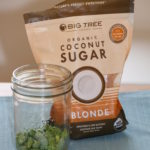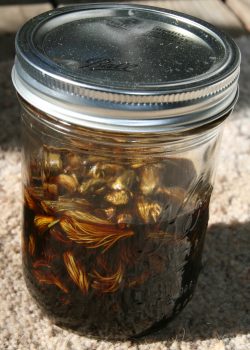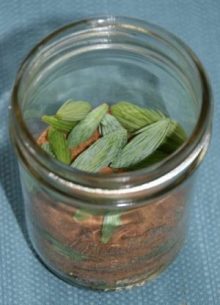I've been digging up my great-grandma's herbal recipes, lately. It's tough to resist the urge to MAKE things - pestos, syrups, salads, liqueurs and other types of deliciousness - when faced with nature's bounty in the late spring. A favorite in May is this two-ingredient cough syrup that's been used in my family for many generations. We happen to have some huge, shady fir- and spruce-trees in our yard, so collecting the wild ingredient was easy this year. No walk in the woods required - though that's usually part of the fun...
The best time to harvest the new shoots is right now, in late May, when they are about an inch long. Be careful not to stress out the tree, and take only what you need. It's customary to take no more than three of the bright green shoots per branch, and to leave the one at the very tip. A mere handful of fresh fir- or spruce-greens will get you a jar of syrup that lasts for up to a year - if you don't use it all up before then. If you're robust, and your family never gets sick, feel free to drizzle some over your favorite dessert - this syrup can lend depth, earthiness and excitement to many summer dishes.
Ingredients
(makes one small jar)
1 handful of freshly harvested fir- or spruce-shoots
1 cup of coconut palm sugar (other raw sugars like demerara will work as well)
Instructions
1. Rinse the shoots in a strainer, and let them dry completely.
2. In a clean glass jar, layer the shoots and the sugar, ending with a double layer of sugar.
3. Put the jar on a sunny window sill, and give the contents a chance to turn into syrup. This will take about two weeks, and you can aid the process by shaking the jar every once in a while.
4. Strain the mixture through a sieve lined with cheesecloth.
5. Store the cough syrup in a small glass jar in a cool, dark place, for up to a year. Add a little bit of raw local honey if the woodsy flavor is a little strong for your taste.




Variations:
1. Add some thyme, if you have it, or try the syrup with buckworth (plantago lanceolata) from a mountain meadow. These herbs have similar phlegm-loosening properties.
2. Of course, this wouldn't be an Austrian remedy without an alcoholic option. Some people swear by the following mixture: 1 large handful shoots in 1 liter (ca. 1 quart) of 'Korn' (a clear, grain-based alcohol that you can substitute with gin), with half a handful of 'Kandiszucker', or unrefined sugar. This concoction takes 6 weeks to macerate in a sunny location, before you strain it and store it in a cool, dark place until you need it.
Why make your own cough syrup?
I personally like knowing what's in my food, and in the medicine I administer to my body. Many common expectorants (mucous-dissolving drugs) list potential side-effects like anxiety, dizziness or restlessness - not what I expect from something that's supposed to make me feel better.
What we know about the active ingredients in our homemade remedy:
The volatile oils in young fir- or spruce-shoots have natural expectorant ingredients like camphene, α-Pinene, and y-3-Carene – y-Bornyl acetate, and sesquiterpenes, that help loosen mucous. They are also full of vitamin C. Spruce oil has hormone-and cortisone-like properties that stimulate the thymus gland and the hypothalamic–pituitary–adrenal axis (HPA). What this means is that both your immune system and the way your body responds to stress can be affected positively by the constituents of the spruce-sap.
There are no known side-effects of spruce-oil or -syrup, but if you are pregnant or have a medical condition, you are advised to err on the side of caution anyways and consult with a knowledgeable natural holistic practitioner.
No time to make syrup or liqueur? Need all that plant goodness a.s.a.p.? Try an infusion, to get SOME of the same benefits: steep 3 or 4 shoots in a cup of hot water for 5-10 minutes. Sweeten with raw, local honey if you want. Enjoy. Breathe.

